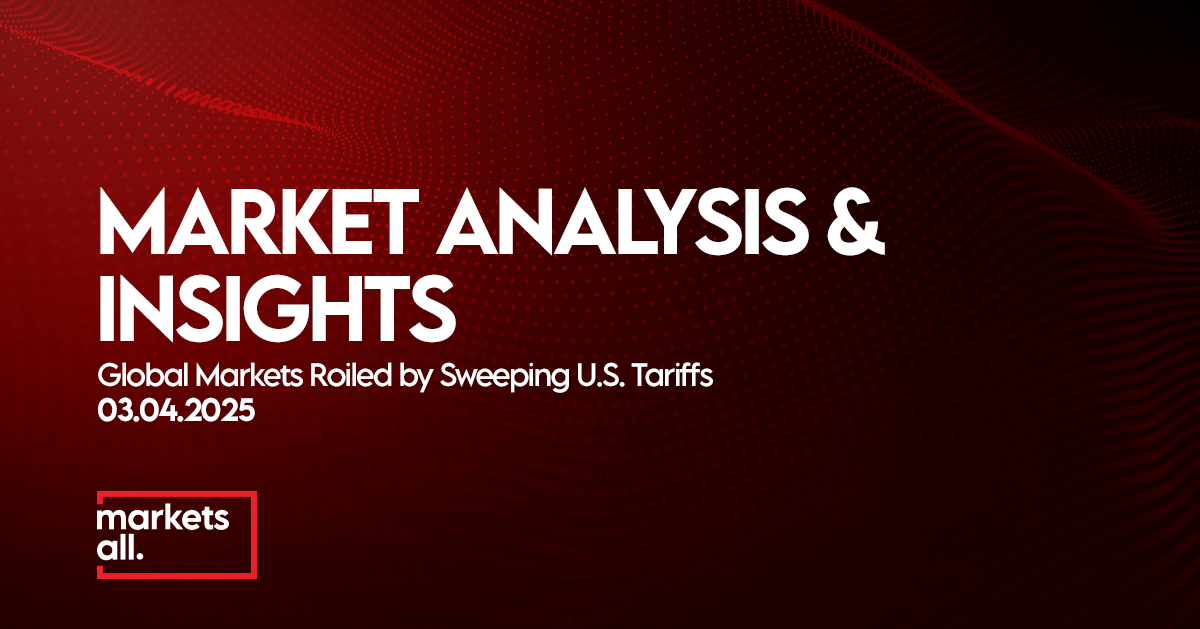On April 2, 2025, global financial markets faced heightened volatility following U.S. President Donald Trump’s announcement of a sweeping set of new import tariffs targeting key U.S. trading partners. The revised trade policy includes a 10% baseline tariff on all imported goods, with significantly higher rates imposed on selected countries:
- 34% on Chinese imports,
- 24% on Japanese products, and
- 20% on European Union exports.
This aggressive trade stance has triggered sharp market reactions worldwide and raised fresh concerns about the future of global trade flows, supply chain stability, and broader economic growth prospects.
🇺🇸 United States
Market Performance
Equities:
U.S. stock indices recorded modest gains during regular trading hours.
- The S&P 500 climbed 0.7%,
- The Dow Jones Industrial Average advanced by 0.6% (approximately 235 points),
- The Nasdaq Composite rose 0.9%.
However, shortly after the tariff announcement, U.S. stock futures plunged, signaling a potential downward shift in investor sentiment and pointing to a likely negative open for the upcoming trading session.
Treasury Yields:
The yield on the 10-year U.S. Treasury note rose to 4.196%, marking the end of a recent downward trend in bond yields. The uptick reflects investor recalibration amid evolving monetary policy expectations and the potential inflationary effects of tariff-driven price increases.
Economic Data
Employment:
The ADP National Employment Report revealed that private-sector employers added 155,000 jobs in March, exceeding forecasts. This positive surprise may temporarily support economic confidence despite rising trade-related risks.
🇪🇺 Eurozone
Market Performance
Equities:
European markets pulled back ahead of the U.S. tariff announcement. The STOXX 600 index fell by as much as 0.5%, reflecting mounting fears of export disruption and weaker global demand.
Economic Data
Inflation:
Eurozone inflation eased to 2.2% in March, now closely aligned with the European Central Bank’s (ECB) official target, offering some relief amid broader uncertainty.
Unemployment:
The Eurozone unemployment rate dropped to a historic low of 6.1% in February, underscoring the region’s labor market strength despite external economic pressures.
🇬🇧 United Kingdom
Market Performance
Equities:
UK equities declined, dragged lower by growing fears that U.S. protectionist policies could tip the global economy toward recessionary conditions.
Economic Data
Services Sector:
While the UK services sector expanded modestly, survey data indicated that business leaders remain deeply concerned about the dual impact of rising U.S. tariffs and impending domestic payroll tax hikes.
🇨🇳 China
Market Performance
Equities:
China’s main stock indices ended flat. However, Chinese tech stocks posted gains of 0.35%, partially offsetting weakness in broader indices.
Economic Data
Services Activity:
The Caixin Services PMI rose to a three-month high, suggesting renewed strength in China’s service sector amid government stimulus efforts and front-loaded export activity.
🇯🇵 Japan
Market Performance
Equities:
The Nikkei 225 Index experienced significant volatility, plunging to an eight-month low after the U.S. imposed a 24% tariff on Japanese goods. It dropped as much as 4.6% intraday, eventually closing down 2.8%, reflecting elevated investor concerns over trade war escalation.
Economic Data
Business Sentiment:
The Bank of Japan’s quarterly survey showed that business sentiment among large manufacturers deteriorated to a one-year low, driven by heightened fears over international trade friction and declining export competitiveness.
🛢️ Commodities
Oil Prices:
Crude oil futures turned negative following the tariff announcement. U.S. crude fell below $70 per barrel, representing a 2% decline, as traders recalibrated expectations for global energy demand in a more fractured trade environment.
Gold Prices:
Gold extended its rally, reaching a new all-time high of $3,148.88 per ounce. The continued surge reflects investor flight to safe-haven assets amid growing uncertainty, with increased central bank purchases, ETF inflows, and algorithmic trend-following strategies all supporting the metal’s rise.
₿ Cryptocurrencies
Market Reaction:
U.S. crypto-related equities fell in premarket trading, as risk-off sentiment swept through markets. Investors appear to be rotating away from risk-sensitive assets like cryptocurrencies due to concerns about global instability and tighter liquidity conditions.
🌐 Outlook
The global financial landscape is entering a period of heightened volatility, driven by the sudden shift in U.S. trade policy. Market participants are now closely watching for retaliatory measures from major economies such as China, Japan, and the European Union, as well as potential responses from central banks. As the dust settles, investors will continue to seek clarity on the economic consequences of this new phase in international trade dynamics.





Leave A Comment